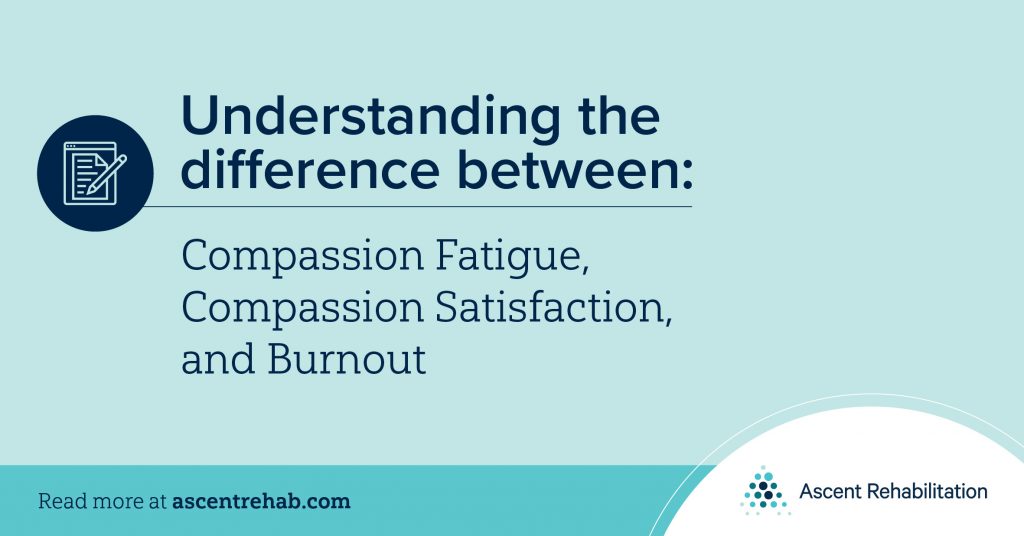The Difference Between Compassion Fatigue, Compassion Satisfaction, and Burnout

The workforce has had significant challenges in the past two years due to COVID-19. Workers who are client/patient facing, and those who work in the helping professions, are at an increased risk of developing compassion fatigue or burnout due to the constant stressors they are exposed to. It is important to be aware of the signs and symptoms of compassion fatigue and burnout, to act in a preventative way, or to seek out the relevant strategies for support when one experiences this.
Compassion satisfaction is on the other end of the spectrum, and ideally, the goal of all workers is to make positive contributions in the workplace, and gain a sense of satisfaction from your valuable input. These three components will be discussed separately in this article.
Compassion fatigue can affect a wide range of professions and caregivers. It is quite common among the helping professions. The concept emerged in 1992, when it was used in a study on Nurses (Joinson, 1992). The term means a “fatigue”, or exhaustion of compassion. Figley, a Psychologist, expanded on this understanding by defining it as “a state of exhaustion and dysfunction, biologically, physiologically, and emotionally, as a result of prolonged exposure to compassion stress,” (Figley, 1995). Symptoms of compassion fatigue can include exhaustion, disrupted sleep, anxiety, headaches, upset stomach, irritability, numbness, a decreased sense of purpose, emotional disconnection, self-contempt, and difficulties with interpersonal relationships.
Compassion satisfaction is about the pleasure one derives from being able to do their work, and from helping others.
You feel positive about your colleagues and your ability to contribute to the work setting, or even the greater good of society. Individuals need to practice self-care strategies to manage stress, and combat compassion fatigue. Some practices that have proven to increase Compassion Satisfaction include:
- Proactively taking charge of, and prioritising the challenges you face.
- Sharing challenges and potential solutions with others.
- Carving out time for ourselves.
- Practicing delegating.
- Establishing a transition and activity time between work and home.
- Learning to say no (or yes) more often.
- Assessing and managing your trauma inputs (consider reducing extra trauma input, e.g., interactions with negative co-workers, distressing or divisive news, disturbing television programs, etc.).
- Joining a peer support group.
- Attending professional training regularly.
- Exercising regularly.
- Actively practicing and internalising gratitude (Eastwoods, 2020).
Finally, Mashlach (2003), emphasises the fact that Burnout has three dimensions: emotional exhaustion (feeling drained), depersonalisation (emotional hardening), and a sense of inefficiency (that work contributions are not effective). Further signs and symptoms associated with burnout are divided into three categories, namely:
Physical symptoms include chronic fatigue, increased susceptibility to illness and infections, frequent headaches, shortness of breath, backaches, gastrointestinal disturbances, and insomnia.
Affective cognitive symptoms include the development of a negative self-concept, suspicion, rigidity, depersonalisation, cynicism, emotional lability, sense of meaninglessness, and alienation. Often these coincide with feelings of depression, lack of motivation, and the feeling that work is drudgery, or that one is losing one’s professional effectiveness.
Behavioural symptoms typically include displays of anger, impatience and irritation, overuse of food, tobacco, alcohol, tranquilisers, and sleeping tablets. Often, these lead to difficulty with finishing tasks, reluctance to get up for work, problematic interpersonal relationships at work and home, finding it increasingly difficult to empathise with clients, reluctance to socialise, impaired concentration and job performance, increased errors and accidents, absenteeism, and staff turnover.
To help mitigate burnout, the following actions are often advised:
- Seek support by reaching out to others, but avoid negative people.
- Reframe the way you look at work to find value in what you do. Take time off if you need to.
- Re-evaluate your priorities, set boundaries, and take short daily breaks from technology to nourish your creative side (try to make time for a hobby, set time aside for yoga, meditation, or breathing exercises). Get enough sleep.
- Make exercise a priority. A ten minute walk can improve your mood for up to two hours.
- Support your mood and energy levels with a healthy diet, avoid nicotine, and minimise alcohol use, (Smith, Segal & Robertson, 2021).
Work-based stressors have become an inevitable part of our daily lives, however, being able to recognise the symptoms correctly is the first step in mitigating the problem. While employees in the helping professions are typically reluctant to step back from their obligations, they need to remain aware of the risks associated with such behaviour. Employees and employers carry the responsibility of remaining vigilant and implementing measures to mitigate, or at least, navigate these pitfalls.
Bibliography
Eastwoods, L.L.C. (2020). What is Compassion Satisfaction and How Can it Help? https://njcommonground.org/what-is-compassion-satisfaction-and-how-can-it-help/
Figley, C. R. (Ed.). (1995). Compassion fatigue: Coping with secondary traumatic stress disorder in those who treat the traumatized. Brunner/Mazel.
Joinson, C., (1992) Coping with compassion fatigue. Nursing 22:116-120.
Mashlach, C. (2003) Job Burnout: New Directions in Research and Intervention. Current Directions in Psychological Science 12(5):189-192. doi:10.1111/1467-8721.01258
Smith, M., Segal, J. & Robertson, L. (2021). Burnout Prevention and Treatment. Obtained from https://www.helpguide.org/articles/stress/burnout-prevention-and-recovery.htm


Leave a Reply